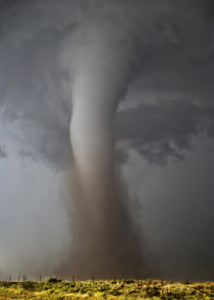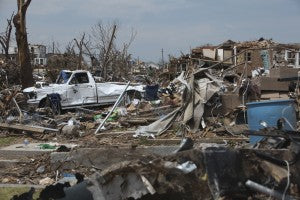When the weather gets blustery and the sky goes dark, no matter where you live you probably have a thought or two about a tornado. In some parts of the country, this kind of weather really could mean a tornado is imminent. In other parts, it’s probably just a storm brewing that won’t have any funnel clouds as a side effect. But no matter where you live, you’re not immune from tornadoes. Sure, they’re more prevalent in what is known as Tornado Alley, but they can also happen in every state in the country. This makes planning for them important for everyone, regardless of location. In order to prepare for a tornado, it would be useful to know what they are. After all, knowing is half the battle.
What’s a Tornado? 
You’ve probably at least seen a picture of a tornado before (if not, check out the image to the right – that’s a tornado). According to The National Severe Storms Laboratory, a tornado “is a narrow, violently rotating column of air that extends from the base of a thunderstorm to the ground.” If the rotating column of air doesn’t connect with the ground, then it’s known as a funnel cloud. As noted, tornadoes are a rotating column of air. Air itself is invisible, so the only way to see a tornado is when its funnel is made up of water droplets, dust, and debris. That’s what gives it its dark color.
How Do They Form? 
Tornadoes mostly form
from thunderstorms. When warm, moist air clashes with cool, dry air, the atmosphere becomes unstable, creating a change in wind direction and increase of wind speed. Increased wind speed and change in wind direction then causes the cloud to spin vertically. Tornadoes form inside this rotating cloud. That’s the science behind it (albeit a little confusing perhaps…). However, it’s still not fully understood how tornadoes actually form. The NSSL explained that tornadoes “can happen without such temperature patterns.” So while those temperature fluctuations are a fairly safe bet for a tornado, that doesn’t mean one won’t form independent of those factors.
How Strong are Tornadoes? 
Tornadoes can range from fairly weak to devastatingly strong. They are ranked according to the Enhanced
Fujita Tornado Damage Scale, which estimates the tornado's strength due to damages. It begins at EF0 and going as high as an EF5. The wind speeds of an EF0 are anywhere from 40-72 mph (considered to bring "light damage"), whereas the wind speeds of an EF5 are over 200 mph ("incredible damage). That’s some crazy wind! And with winds that fast, nothing is safe. Fortunately, EF5’s don’t happen as frequently as others. In fact, there have only been
59 officially rated EF5 tornadoes in the United States since 1950. While not frequent, that’s still quite a bit for something so powerful. Tornadoes are scary, but according to Accuweather, your odds of being hit by a tornado are pretty slim. That being said, if you live in Tornado Alley, your odds just increased exponentially. For those outside that wind tunnel of states, odds are much lower. But remember – tornadoes do happen in every state, so no matter where you live, be prepared!
How have you prepared for a tornado in your area? Let us know in the comments! 
 You’ve probably at least seen a picture of a tornado before (if not, check out the image to the right – that’s a tornado). According to The National Severe Storms Laboratory, a tornado “is a narrow, violently rotating column of air that extends from the base of a thunderstorm to the ground.” If the rotating column of air doesn’t connect with the ground, then it’s known as a funnel cloud. As noted, tornadoes are a rotating column of air. Air itself is invisible, so the only way to see a tornado is when its funnel is made up of water droplets, dust, and debris. That’s what gives it its dark color. How Do They Form?
You’ve probably at least seen a picture of a tornado before (if not, check out the image to the right – that’s a tornado). According to The National Severe Storms Laboratory, a tornado “is a narrow, violently rotating column of air that extends from the base of a thunderstorm to the ground.” If the rotating column of air doesn’t connect with the ground, then it’s known as a funnel cloud. As noted, tornadoes are a rotating column of air. Air itself is invisible, so the only way to see a tornado is when its funnel is made up of water droplets, dust, and debris. That’s what gives it its dark color. How Do They Form?  Tornadoes mostly form from thunderstorms. When warm, moist air clashes with cool, dry air, the atmosphere becomes unstable, creating a change in wind direction and increase of wind speed. Increased wind speed and change in wind direction then causes the cloud to spin vertically. Tornadoes form inside this rotating cloud. That’s the science behind it (albeit a little confusing perhaps…). However, it’s still not fully understood how tornadoes actually form. The NSSL explained that tornadoes “can happen without such temperature patterns.” So while those temperature fluctuations are a fairly safe bet for a tornado, that doesn’t mean one won’t form independent of those factors. How Strong are Tornadoes?
Tornadoes mostly form from thunderstorms. When warm, moist air clashes with cool, dry air, the atmosphere becomes unstable, creating a change in wind direction and increase of wind speed. Increased wind speed and change in wind direction then causes the cloud to spin vertically. Tornadoes form inside this rotating cloud. That’s the science behind it (albeit a little confusing perhaps…). However, it’s still not fully understood how tornadoes actually form. The NSSL explained that tornadoes “can happen without such temperature patterns.” So while those temperature fluctuations are a fairly safe bet for a tornado, that doesn’t mean one won’t form independent of those factors. How Strong are Tornadoes?  Tornadoes can range from fairly weak to devastatingly strong. They are ranked according to the Enhanced Fujita Tornado Damage Scale, which estimates the tornado's strength due to damages. It begins at EF0 and going as high as an EF5. The wind speeds of an EF0 are anywhere from 40-72 mph (considered to bring "light damage"), whereas the wind speeds of an EF5 are over 200 mph ("incredible damage). That’s some crazy wind! And with winds that fast, nothing is safe. Fortunately, EF5’s don’t happen as frequently as others. In fact, there have only been 59 officially rated EF5 tornadoes in the United States since 1950. While not frequent, that’s still quite a bit for something so powerful. Tornadoes are scary, but according to Accuweather, your odds of being hit by a tornado are pretty slim. That being said, if you live in Tornado Alley, your odds just increased exponentially. For those outside that wind tunnel of states, odds are much lower. But remember – tornadoes do happen in every state, so no matter where you live, be prepared! How have you prepared for a tornado in your area? Let us know in the comments!
Tornadoes can range from fairly weak to devastatingly strong. They are ranked according to the Enhanced Fujita Tornado Damage Scale, which estimates the tornado's strength due to damages. It begins at EF0 and going as high as an EF5. The wind speeds of an EF0 are anywhere from 40-72 mph (considered to bring "light damage"), whereas the wind speeds of an EF5 are over 200 mph ("incredible damage). That’s some crazy wind! And with winds that fast, nothing is safe. Fortunately, EF5’s don’t happen as frequently as others. In fact, there have only been 59 officially rated EF5 tornadoes in the United States since 1950. While not frequent, that’s still quite a bit for something so powerful. Tornadoes are scary, but according to Accuweather, your odds of being hit by a tornado are pretty slim. That being said, if you live in Tornado Alley, your odds just increased exponentially. For those outside that wind tunnel of states, odds are much lower. But remember – tornadoes do happen in every state, so no matter where you live, be prepared! How have you prepared for a tornado in your area? Let us know in the comments! 


3 comments
Maria C.
I live on the east coast, and I’m not as prone to tornadoes as other states are. But I’ve prepared for a tornado. I have a basement without windows, I have food and water plus all the dog supplies we need for at least 72 hours. Honestly I’ve planned for ten days of food, water, & snacks. I feel better having extra food & water just in case.
Caroline Salzarulo
I live in Selma, Alabama, we get lots of Tornados here, It’s said that we are in more danger because they usually hit at night when everyone is in bed
desiree
my dog and i have the water and some the stuff in hall we have a safe room and then there kennel they get in to and blanekt with in reach and then they have stress jackets